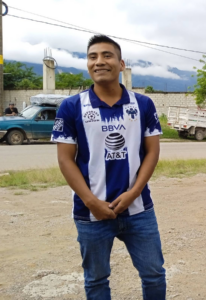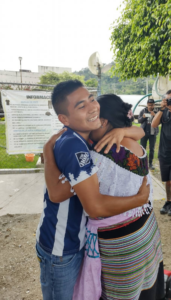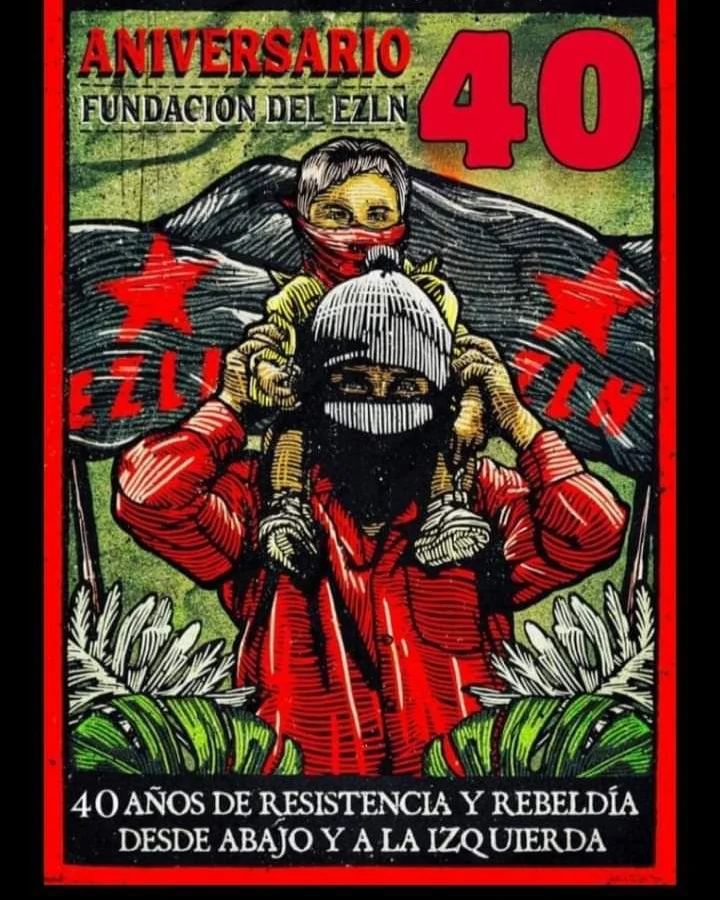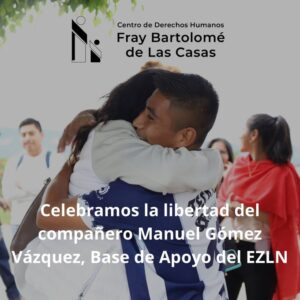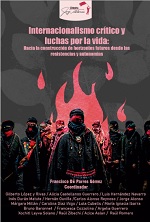
Thirteenth Part: TWO FOOTBALL GAMES AND THE SAME REBELLION
Thirteenth Part: TWO FOOTBALL GAMES AND THE SAME REBELLION.
“Football is the continuation of politics by other means.”
Don Durito de La Lacandona (“DD”, for legal purposes).
November 2023
I.- Eve of the Journey for Life – Europe chapter.
A football challenge has been received from a European women’s team that resists and fights.
SupGaleano has appointed himself “technical director” of the “Ixchel – Ramona” team, made up of militiawomen. As it should be, the Sup has studied the rival team. He gathers the compañeras who will make the trip. Analyzes in detail the skills and characteristics of each of the players. He goes to Subcommander Moisés and gives his diagnosis: “they are going to tear us into pieces.” SubMoy looks at it with a “so?” face, as if taking it for granted. But the now deceased has not finished: “But I have a secret plan, as Dení says. With that we will revolutionize football and redefine it in its essence: the game.”
Subcommander Insurgent Moisés, coordinator of the tour, is quite busy with the preparation courses, birth certificates, passports and the design of the route to follow, so he leaves SupGaleano to proceed “at his discretion.” The future deceased smiles and says: “Discretion is my second last name” (don’t ask me what his first last name was because it would take several pages to explain it to you).
The deceased in the making begins the preparation of the women’s team. But, for his strategy to be successful, he needs the support of the fearsome, terrible and terrifying “Popcorn Commando”, which, at that moment, is trying to open a hole in the training ship in which the so-called “Squadron 421” was prepared. Disillusioned because, before finishing the work below the waterline, the ship had been transformed into an imposing two-engine plane, they went to consult with SupGaleano what they could do to set the aircraft on fire. The Sup convinced them that it was not advisable to burn it, that it was better to wait until it was in full flight to shoot it down from within. The beloved Amado and Chinto objected: if the plane falls, Commando Palomitas will also fall. The Sup responded that it was not the time to dwell on trifles. Furthermore, the Command was required for a higher task, than sabotaging an air trip that did not even complete the payment for the tickets, not to mention the lack of passports, and that the majority of the so-called “Division Aerotransportada La Extemporánea” was getting dizzy in the truck.
When the Popcorn Commando, the Sup, Tzotz, Tragón and Pelusa met in the ultra-secret bunker that is in the Puy platform of the Tzotz Choj area, they proceeded to refine the details of what, from then on, would be known worldwide as the “Brilliant and Excellent Plan to Defeat a Rival Better Prepared, Trained and Equipped than Us” (BEPDRMPEEN, for its acronym in Spanish), subtitle “And that they have better technique and control of the ball.”
The top secret meeting continued its normal course. That is to say, Chuy took away Lupita’s chamoy lollypop, Verónica gave Chuy a slap and, as if it were the Supreme Government, she kept Chuy’s lollypop, Lupita’s and her own. El Chinto and the beloved Amado insisted that their bicycles had broken down “just like that” and that the Monarch had to fix them. Pelusa, Tragón and Tzotz looked at the table looking for cookies, and Sup gave a master class on “How to win a soccer game with everything against you.”
The apparent chaos subsided when the Sup took out, from who knows where, a box of “Choki The Devil’s Cookie”, and only then – after 5 packages had been dispatched – the missions were distributed, the schedule was made, and they stuffed themselves with the sixth package “in honor of the future fallen men.” “And women,” Chuy felt obliged to add, only to receive from Verónica another zap model “gender equality does not apply in misfortune.” Lupita approved the action with the chamoy lollypop that Sup gave her so she wouldn’t continue crying.
The “three times T” Popcorn Command, the Sup and the canine wing of the command then went to the hotbed and, with the militia members gathered, the new “passive-aggressive” scheme was explained and practiced, which, as it should be, had in a leading role the aforementioned Command.
Following the old and proven Zapatista rule of “Do not play with the enemy’s rules”, the Sup developed a kind of mixture of rugby, with nineteenth-century dramaturgy, with some Anime, with cinema very much like Hollywood corner with Cannes, with Monet’s impressionism, a pinch of Allan Poe crossed with Conan Doyle, something of Cervantes’ epic, the brevity of Joyce, the perspective of Buñuel, a pinch of Brecht mixed with Beckett, the seasoning of some tacos al pastor, a very rebajada cumbia, Anita Tijoux and Shadia Mansour breaking borders -free Palestine-, and, well, I didn’t take note of everything, but the only thing missing was the ball.
The strategy in question had 3 phases:
The first was that Verónica grabbed a Zapatista doll and headed determinedly towards the opposing goal, she stood in front of the enemy goalkeeper and spoke to her in Cho’ol. The goalkeeper, of course, world not understand anything, but there stood Lupita and Esperanza Zapatista who would translate with signs that the girl was giving her the doll. And Esperanza, as her name indicates, offered to take a photo with the girl and the doll. For the photo, they should tell the goaly to put the ball down, because Verónica wanted her to hug her. At the moment this happened, Esperanza kicked the ball “into the back of the net” and the entire team shouted “Goal!” It was practiced countless times with success. The only thing that could not be achieved was for Verónica not to take the doll from the goalkeeper and run away.
The second variant consisted of the Zapatista goalkeeper receiving the ball, placing it under her sports shirt, as if she were pregnant, and beginning to walk as if pregnant. The entire Zapatista team came to help her and take her to medical services. Of course, since they were in foreign territory, the teammates made a mistake and went to face the enemy goal, where, miraculously, the Zapatista goalkeeper dropped the ball that, barely rolling, went beyond the enemy line and gave birth to a Goal that he forgot from Messi and Cristiano. Meanwhile, the TTT Popcorn Commando surrounded the sister responsible for the board and “exhorted” her to accept the goal achieved “with the sacrifice of the Zapatista comrade and her little ball.”
The third variant implied a risk for the protagonist, since she had to fake fainting. It was practiced only once in the seedbed because the terrain there is gravel (stone and sand), and it was expected that there would be grass in the enemy field. The compañera had to faint in the middle of the field. Subcommander Moisés, alarmed, would run to see his companion and, with him, the entire Zapatista bench would run. All the compañeras cried out, in their respective mother tongues, for medical service. As expected, the enemy would have no medical service, so a stretcher would be prepared in advance. The referee would like to call the paramedics, but SubMoisés would allege practices and customs of the native peoples, so the Zapatistas themselves lift the fainted woman and place her on the stretcher. Confused by the pain and sorrow of seeing their sister fall in combat, the militia members would not succeed in heading to the bench carrying the stretcher, so they would end up reaching the enemy goal. At that moment, the first gods, those who made the world, would do their work and the injured compa would wake up without the need for any male toad, commoner or royalty, to kiss her, and she would find the ball at her feet, just on the goal line and with a kick she would seal the fate. It was to be expected that, animated by the joy of seeing their companion safe, the militiawomen would shout “Goal!” By that time, the Popcorn Commando would already be at the foot of the scoreboard to ensure that life was celebrated.
I don’t really remember the fourth – I know I said there were 3, but weren’t the three musketeers actually 4? -, although it was similar in wit, creativity and mischief to the other three.
According to what the militia women told me upon their return, in the territories they call “Italy” and “Spanish State”, the enemy sisters quickly understood what the matter was about and began to play with the same style. I don’t know whether FIFA could classify it as football but, judging by the photos and videos they showed me, it was a party. Result: there was no winner or loser… and Verónica returned with the doll that, presumably, belonged to the now deceased SupGaleano. No, she didn’t give it back.
“And that was the message for geographies around the world: do not play with your enemy’s rules, create your own rules,” SupGaleano declared to me before his last sigh.
-*-
II.- How many Cyprus can fit in a soccer game?
This was told to me by Subcommander Insurgent Moisés, when he told me details and anecdotes from the so-called “Europe chapter” of the Journey for Life. What I tell below is what I managed to rescue from the narration, full of admiration and respect, of Subcommander Moisés.
“There is a geography called Cyprus. Well, it’s broken, that is, in pieces. There are Cypriots, there are Greek Cypriots and there are Turkish Cypriots and I don’t remember how many more people have the last name Cypriot. The capitalists divided that land, cut it into pieces. And they also cut up their people, their language, their history, their culture. And it turns out that, although it is a small island, all the money wants it and, as they do, they divide it, but each party wants the other’s share. In other words, in the midst of the powerful and their wars, the people remain.
Well, then there is a soccer team in that geography called Cyprus. They have good players and they are professionals. So their job is to play soccer. So they are losing several games and they meet among themselves to analyze and they say that they are losing because the games’ strategy is wrong. They go and tell the owner of the team, that is, the boss, that they are losing because of that, that they already thought of a better strategy and that way they will win more games.
The boss, that is, the owner of the team, looks at them with contempt and tells them: “you win or lose as it suits me. Sometimes it suits me that you lose and that’s how it will continue.»
The players know how to play very well, but they also have a good heart. So, as they say, they rebel. They tell themselves resistance and rebellion, but in their language. And they send the owner of the team, that is, the boss, to hell. Then they make their own soccer team. And they organize themselves and make a stadium. That land is divided, so, in the middle, they say “no man’s land”, they make their stadium there and then they invite anyone who wants to play and practice. The other groups and collectives that fight, support them and are well organized. It doesn’t matter if you are Cypriot, Greek Cypriot, Turkish Cypriot or Cypriot I don’t know what. There is no charge, it is voluntary what each person wants to give. So, as they say, the pay is not what matters. So, from time to time they have their matches and there are no divisions of nationalities, no religions, no flags, there is only football. And it’s like a party.
In other words, as they say, those brothers broke those boundaries that the bosses and owners put in place.
“So they kind of made their Caracol. They have a football Caracol! I told them let’s see when we can have a soccer game there in their land or here in no man’s land,» says Subcommander Insurgent Moisés, spokesperson for the Zapatista communities, chief of the EZLN, and coordinator of the Journey for Life.
-*-
- Cheers and that the games, like the rides, are not a competition but rather excuses to coexist among different people.
I attest
From the mountains of the Mexican southeast.

The Captain
Mexico, November 2023. 40, 30, 20, 10, 2 years later.
Music: «Somos Sur», for Ana Tijoux and Shadia Mansour
Images of the soccer match between the Ixchel-Ramona team and the enemy Italian sisters taken in the geography they call Rome, Italy, in November 2021. Added to images of mobilization of the Zapatista peoples against the wars in 2022. Tercios Compas . Copyleft November 2023
EZLN | Twelfth part: Fragments.
Twelfth part: Fragments
Fragments of a letter written by Subcommander Insurgent Moises, sent a few months ago, to a geography distant in space but close in thought:
“Sixth Zapatista Commission.
Mexico.
April 2023
(…)
Because then it would be something like, in the face of the terrible storm that is already hitting every corner of the planet, even those who thought themselves safe from all evil, we did not see the storm.
I mean, we don’t just see the storm, and the destruction, death and pain that it brings. We also see what comes next. We want to be the seed of a future root that we will not see, which will then be, in turn, the grass that we will not see either.
The Zapatista vocation, if someone pushes us to a laconic definition, is “to be a good seed.”
We do not intend to leave for inheritance a conception of the world to the next generations. Neither to inherit our miseries, our resentments, our pain, our phobias, or our philias. Nor for them to be a mirror with a more or less approximate image of what we assume is good or bad.
What we want to leave for inheritance is life. What other generations do with it will be their decision and, above all, their responsibility. Just as we inherited life from our ancestors, we took what we considered valuable, and we assigned ourselves a task. And, of course, we take responsibility for the decision we made, for what we do in order to accomplish that task, and for the consequences of our actions and omissions.
When we say that “It is not necessary to conquer the world, it is enough to do it again”, we move away, definitively and irremediably, from the current and previous political conceptions. The world we see is not perfect, not even close. But it is better, without a doubt. A world where everyone is who they are, without shame, without being persecuted, mutilated, imprisoned, murdered, marginalized, oppressed.
What is that world called? What system supports it or is dominant? Well, that will be decided, or not, by those who live there.
A world where the desires to hegemonize and homogenize learn from what they caused in this time and other times, and fail in that world to come.
A world in which humanity is not defined by equality (which only hides the segregation of those who “are not equal”), but by difference.
A world where difference is not persecuted, but celebrated. A world in which the stories told are not those of those who win, because no one wins.
A world where the stories that are told, whether in intimacy, or in the arts, or in culture, are like those that our grandmothers and grandfathers told us, and that teach not who won, because no one won and, therefore, nobody lost.
Those stories that allowed us to imagine terrible and wonderful things and in which, between the rain and the smell of cooking corn, coffee and tobacco, we managed to imagine an incomplete world, yes, clumsy too, but much better than the world that our ancestors and our contemporaries have suffered and are suffering.
We do not intend to leave for inheritance laws, manuals, worldviews, catechisms, rules, routes, destinations, steps, companies, which, if you look closely, is what almost all political proposals aspire to.
Our goal is simpler and terribly more difficult: to leave life for inheritance.
(…)
Because we see that this terrible storm, whose first gales and rains are already hitting the entire planet, is arriving very quickly and very strongly. So, we don’t see the immediate. Or yes, but according to what we see in the long term. Our immediate reality is defined or in accordance with two realities: one of death and destruction that will bring out the worst in human beings, regardless of their social class, their color, their race, their culture, their geography, their language, their size; and another of starting over, from the rubble of a system that did what it does best, that is, to destroy.
Why do we say that the nightmare that already exists, and that will only get worse, will be followed by an awakening? Well, because there are those, like us, who are determined to look at that possibility. Minimal, it’s true. But every day and at all hours, everywhere, we fight so that this minimal possibility grows and, although small and unimportant –just like a tiny seed—, it grows and, one day, it becomes the tree of life that will be of all colors or won’t be at all.
We are not the only ones. In these 30 years we have leaned out into many worlds. Different in ways, times, geographies, own stories, calendars. But equal only in the effort and the absurd gaze placed on an untimely time that will happen, not because of destiny, not because of divine design, not because someone loses so that someone wins. No, it will be because we are working on it, fighting, living and dying for it.
And there will be a meadow, and there will be flowers, and trees, and rivers, and animals of all kinds. And there will be grass because there will be roots. And there will be a girl, a boy, a child who will be alive. And the day will come when she/he will have to take responsibility for the decision she/he makes about what to do with that life.
Isn’t that freedom?
(…)
And we will tell you the story of the indigenous woman of Mayan roots, over 40 years old, who fell dozens of times while learning to ride a 20-wheeled bicycle. But also, got up the same number of times and is now riding a 24 or 26-wheeled bicycle and, with it, she will reach the medicinal plants courses.
Of the health promoter who will arrive on time, to a remote community without a paved road, to administer anti-viper serum to an elderly man attacked by a nauyaca viper.
Of the indigenous, autonomous authority who, with her ‘nagüa’ and her ‘morraleta’, will arrive on time to an assembly of “as women that we are” and will be able to give the talk on feminine hygiene.
And that, when there was no vehicle, gasoline, driver or passable road, to the extent of our development and possibilities, health would reach a champa in a corner of the Lacandon jungle.
A champa where, around a stove, raining and without electricity, the education promoter will arrive, also by bicycle, and, among the smell of cooked corn, coffee and tobacco, she will hear a terrible and wonderful story, told in the voice and tongue of an old woman. And in that story there will be talk about Votán, who was neither man nor woman nor “otroa”. And it was not one, but many. And she will hear her say: “that is what we are, Votán, guardian and heart of the people.”
And that, already at school, that education promoter will tell the Zapatista boys and girls that story. Well, more like the version that she will make of what she remembers having heard, because it couldn’t really be heard, due to the noise of the rain and the muffled voice of the woman who was telling the story.
And about “the cumbia of the bicycle” that some musical youth group will create and that will relieve us all from hearing “the cumbia of the frog” for the umpteenth time.
And our dead, to whom we owe honor and life, perhaps will say “well, we have finally entered the age of the wheel.” And at night they will look at the starry sky, without clouds to hide it, and they will say “Bicycles! From there, the spaceships follow.” And they will laugh, I know. And someone alive will start a tape recorder and a cumbia will be heard that all of us, the living and the dead, hope is not “la del moño colorado.”
(…)
From the mountains of the Mexican southeast.
In the name of the Zapatista boys, girls, men, women and ‘otroas’.
Subcommander Insurgent Moisés.
General Coordinator of the “Tour for Life”.
Mexico, April 2023.”
These fragments are taken from the original, and with the authorizations of the sender and recipient.
I attest.

The Captain.
November 2023

